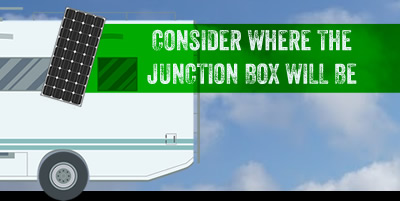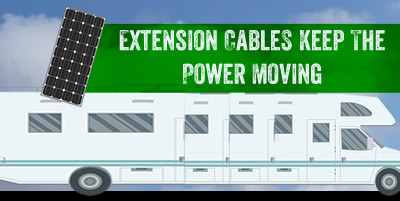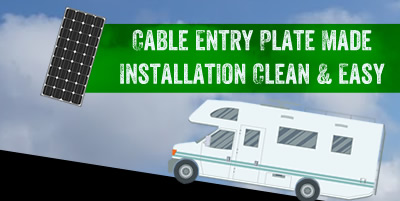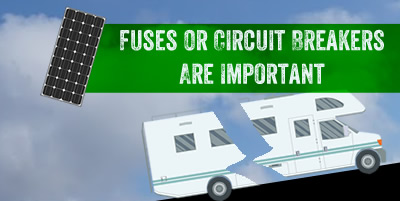Learn More About RV Solar Kits
RV Solar Kits are designed to provide many of the required components that an end-user would need to have the solar panels installed on their RV roof. These permanent mount solar panel kits should not be confused with the portable solar kits, you can learn more about these in our portable solar guide. These are solar kits for RV use.

What Makes RV Solar Kits Work Well?
Here are the basic components of a RV Solar Kit:
| Solar Panels for RVs | Mounting Brackets | | Mounting Hardware | Junction Box and Cables | | Branch Connectors | Extension Cables | | Cable Entry Plate | Fuse or Breaker | | Solar Charge Controller | |
The Panels in RV Solar Kits
 Solar panels for RV use are high quality photo-voltaic solar panels designed to be installed in mobile and recreational vehicle applications. There are many sizes and types of the power generating panels on the market. Although quality differs significantly from brand to brand in panels. It is always our recommendation to buy equipment built by a trusted brand that designs and engineers the panel for use on an RV. So many cheap panels have flooded the markets over the past years, it is more important than ever to choose wisely.
Solar panels for RV use are high quality photo-voltaic solar panels designed to be installed in mobile and recreational vehicle applications. There are many sizes and types of the power generating panels on the market. Although quality differs significantly from brand to brand in panels. It is always our recommendation to buy equipment built by a trusted brand that designs and engineers the panel for use on an RV. So many cheap panels have flooded the markets over the past years, it is more important than ever to choose wisely.
Here are a few types of different solar panels that have been included in RV solar kits over the years.
- Rigid MonoCrystaline Panels – these are the most common panels included in solar kits designed for customers who would like to boondock or dry camp. These panels often have the best warranty and also are the most durable.
- Flexible Solar Panels – These semi rigid panels have a nice ability to flex enough to match the curves on many campers like Airstreams and canned hams. These panels usually have a shorter warranty period and are more easily damaged from even small limbs.
- Super Flexible Panels – These super flexible panels or thin film panels have been popular over the years but have gone down in popularity due to their inefficient ability to turn sun light into electricity. This means they take up more roof space to produce the same amount of power. They also suffer easy damage if bent beyond a certain point.
- Amorphous Silicon Panels – These were some of the first solar panels. They are still used today although usually in smaller low end solar panels. This is because these types of panels are cheap to make. They are not efficient and are easily broken. There have been some improvements in their efficient, but we have not seen these in the larger solar kits at this time.
Mounting Brackets For The Roof And Panel
 Mounting brackets for solar panels on RV roofs may often be considered last, but these brackets keep your panel securely mounted and spaced off your roof. The most popular bracket used for RV roofs is the Z bracket. This bracket gets its name from the shape it is bent into. The brackets often have two different hole patterns on each end. This is because the two patterns are designed for different purposes. The small holes are usually designed to attach screws through. The larger elongated oval shape hole is designed to connect to the solar panel, its shape providing flexibility when installing to the bracket on the RV.
Mounting brackets for solar panels on RV roofs may often be considered last, but these brackets keep your panel securely mounted and spaced off your roof. The most popular bracket used for RV roofs is the Z bracket. This bracket gets its name from the shape it is bent into. The brackets often have two different hole patterns on each end. This is because the two patterns are designed for different purposes. The small holes are usually designed to attach screws through. The larger elongated oval shape hole is designed to connect to the solar panel, its shape providing flexibility when installing to the bracket on the RV.
Mounting Hardware Joins Panel and RV
 The mounting hardware that is included with the solar kits is key for joining the solar panel to the mounting bracket and the mounting bracket to the RV roof. Most of the time the RV solar kit package will include screws for mounting the bracket to the roof and nuts and bolts for mounting the bracket to the solar panel. Remember the screws are not water tight and will needed to be made water proof after installing. Water does not mix well with RV’s. If you are considering adding tilt mount brackets, you should consider how this will impact these items in your solar kit.
The mounting hardware that is included with the solar kits is key for joining the solar panel to the mounting bracket and the mounting bracket to the RV roof. Most of the time the RV solar kit package will include screws for mounting the bracket to the roof and nuts and bolts for mounting the bracket to the solar panel. Remember the screws are not water tight and will needed to be made water proof after installing. Water does not mix well with RV’s. If you are considering adding tilt mount brackets, you should consider how this will impact these items in your solar kit.
Junction Box and Cables On The Roof
 The junction box is the section on the back of the panel where the electrical components terminate and are connected to the solar lead cables. In the early days these were very simple leaky components on top rail of the panel. The junction box is now a water tight way to securely connect to the solar panel. The panels usually have solar cable leads that are about 18 inches long and are terminated using MC4 connectors. These connectors allow easy watertight connections. Consider where the junction box will land on your RV install because having the junction box further away could mean having to purchase solar extension cables.
The junction box is the section on the back of the panel where the electrical components terminate and are connected to the solar lead cables. In the early days these were very simple leaky components on top rail of the panel. The junction box is now a water tight way to securely connect to the solar panel. The panels usually have solar cable leads that are about 18 inches long and are terminated using MC4 connectors. These connectors allow easy watertight connections. Consider where the junction box will land on your RV install because having the junction box further away could mean having to purchase solar extension cables.
Branch Connectors, They Bring Things Together
 Branch connectors are designed to join panels together in parallel wiring setups. They are sometimes called Y connectors. An easy way to look at a branch connector is that it will take two + connectors from different solar panels and turn them into one + cable to wire to the cable entry plate. The ingenious connectors keep everything nice and watertight on your RV roof. It is also possible to stack the Branch Connectors making them even more adaptable. Branch connectors come in many varieties but the most common are the MC3 and the MC4 versions. The MC4 is considered the standard today.
Branch connectors are designed to join panels together in parallel wiring setups. They are sometimes called Y connectors. An easy way to look at a branch connector is that it will take two + connectors from different solar panels and turn them into one + cable to wire to the cable entry plate. The ingenious connectors keep everything nice and watertight on your RV roof. It is also possible to stack the Branch Connectors making them even more adaptable. Branch connectors come in many varieties but the most common are the MC3 and the MC4 versions. The MC4 is considered the standard today.
Extension Cables Keep The Power Moving
 Keeping all the power moving along sometimes requires making a jump between points. This is best completed by using solar extension cables. Although not normally part of many of the RV solar kits, these cables are very important. This is one of the reason many people turn to Outside Supply to help get the right system. We carry extension cables in 2, 3,6,10, 12 and 25 foot lengths. We have limited stock of MC3 extension cables. We have lots of stock on the MC4 solar extension cables.
Keeping all the power moving along sometimes requires making a jump between points. This is best completed by using solar extension cables. Although not normally part of many of the RV solar kits, these cables are very important. This is one of the reason many people turn to Outside Supply to help get the right system. We carry extension cables in 2, 3,6,10, 12 and 25 foot lengths. We have limited stock of MC3 extension cables. We have lots of stock on the MC4 solar extension cables.
Solar Charge Controller Keeps Batteries Charged And Healthy
 The solar charge controller is one of the most important parts of a RV solar kit. This device will keep your batteries from being overcharged and on certain controller models will let you know how many amps are going into your battery bank. Many of the models also will let you set the proper charge algorithm for your battery type. This setting will change the charge voltage and float voltage depending on battery type. There are different types of charge models on the market today: The Shunt Controller, The PWM Controller, and The MPPT controller. We find that the PWM charge controllers are better for smaller solar arrays and the MPPT charge controllers are better for arrays over 400 watts.
The solar charge controller is one of the most important parts of a RV solar kit. This device will keep your batteries from being overcharged and on certain controller models will let you know how many amps are going into your battery bank. Many of the models also will let you set the proper charge algorithm for your battery type. This setting will change the charge voltage and float voltage depending on battery type. There are different types of charge models on the market today: The Shunt Controller, The PWM Controller, and The MPPT controller. We find that the PWM charge controllers are better for smaller solar arrays and the MPPT charge controllers are better for arrays over 400 watts.
Cable Entry Plate, Thanks Go Power!
 The cable entry plate is a new addition from Go Power. This device allows clean installs and cable routing from the solar panels to the cable entry plate. Then the cable is run from the entry plate down through the RV. The cables are wired into the charge controller. The cable entry plate is specifically designed for MC4 solar connectors. Many new RVs are being prewired using the Go Power Cable Entry Plate. This unit is also used by many individuals building or remodeling their own camper or conversion van. The cable entry plate was designed by Go Power to allow users to make watertight connections on the roof when the unit is properly sealed. Get your sealant out, your going to need it.
The cable entry plate is a new addition from Go Power. This device allows clean installs and cable routing from the solar panels to the cable entry plate. Then the cable is run from the entry plate down through the RV. The cables are wired into the charge controller. The cable entry plate is specifically designed for MC4 solar connectors. Many new RVs are being prewired using the Go Power Cable Entry Plate. This unit is also used by many individuals building or remodeling their own camper or conversion van. The cable entry plate was designed by Go Power to allow users to make watertight connections on the roof when the unit is properly sealed. Get your sealant out, your going to need it.
Fuse or Breaker, Safety First
 Fuses are circuit breakers are safety features used to help prevent things like electrical fires. Make sure that if you have been instructed to fuse your circuit, you use the proper protection required for your circuit. Many RV solar kits designed for campers and motor homes will come with fuses as part of their package. It is always better to be safe when setting up any electrical system. Take the time and get it done right and safely.
Fuses are circuit breakers are safety features used to help prevent things like electrical fires. Make sure that if you have been instructed to fuse your circuit, you use the proper protection required for your circuit. Many RV solar kits designed for campers and motor homes will come with fuses as part of their package. It is always better to be safe when setting up any electrical system. Take the time and get it done right and safely.
Fuses are designed as single use protection devices in a circuit. If a fuse is blown it will need to be replaced.
Circuit breakers, although more expensive, can be reused even after being tripped. The can also be an easy way to temporarily disconnect a circuit when needed.
Our Most Popular RV Solar Kit ~ 9 Amps
The 170 Watt RV solar kit by Go Power has proved to be the most popular and robust solar kit on the market. Using their durable high quality and high efficiency mono crystalline panels this kit really packs some power. Rated at 8.9 amps per panel, it is the base from which larger systems can be built. In fact 3 170 watt solar panels can be operated on the 30 Amp Charge Controller included in the Kit.
The panel size is 58.3 x 26.5 x 1.4”. it weighs in at a little over 24 lbs. The included panel is designed for maintenance free operation and will provide decades of uninterrupted power. In fact it includes a 25 year solar panel warranty. Using the parts included in the kit it will be easy to install and will include a flush mountable designed solar controller.
This is a high quality RV solar kit designed for permanent installation by Go Power. Call our office at (We No Longer Take Phone Calls) for more information on this kit.
Don’t Forget The Sealant, Water Does Not Mix With RVs
RV solar kits don’t usually come with any type of sealant. This is because customers often have favorite brands and or colors. Make sure you use plenty of high quality sealant to properly seal your installation. Water is the enemy of your RV and a leak can be disastrous. Water tight is key. Remember this panel will be up their for decades, so don’t cut corners on water tight. Also don’t skimp on the sealant. I also like to check and add sealant as necessary every year on my RV roof. Thirty minutes of prevention can really save from a huge expense.
Vehicles that these kits are often installed on:
 ](https://www.rollingwiththewhitneys.com/)
Class A Motorhomes – Large driving motor homes that are often powered by either a gasoline engine or a diesel engine. These larger units ranging from 30 feet to 40+ feet in length usually have lots of room on the roof for solar panels. They also benefit from having large battery compartments and can store reasonably sized battery banks. Owners of these units usually purchase 3 panels and wire either using the refrigerator chase or a pre wired Cable Entry Plate by Go Power.
](https://www.rollingwiththewhitneys.com/)
Class A Motorhomes – Large driving motor homes that are often powered by either a gasoline engine or a diesel engine. These larger units ranging from 30 feet to 40+ feet in length usually have lots of room on the roof for solar panels. They also benefit from having large battery compartments and can store reasonably sized battery banks. Owners of these units usually purchase 3 panels and wire either using the refrigerator chase or a pre wired Cable Entry Plate by Go Power.
**Class B Conversion Vans –**Smaller motorized RV units that are usually built on a van chassis and allow comfortable sleeping arrangements with the benefits of size and are very easy to get around and park. These unit usually purchase 1 to panels to run items like dc refrigerators from brands like Engel. AGM batteries should always be used if the Class B van’s batteries are located in the inside and not vented.
**Class C RV Camper –**The are the most popular of the motorized RV’s. They are famous for having cab over bunks for sleeping Many children have fond memories of waking up in a national park and climbing down from their bunk in a Class C. These units usually range from 24 Feet to 34 feet in length. Most owners will purchase between 2 to 3 panels for their unit. They will use the refrigerator chase or AC chase for wiring. They also usually have the ability to store a decent number of AGM batteries.
**Fifth Wheel Trailers –**The are the big boys of camping with a trailer. Know for their stability when towing, I like to think of their large roof spaces as perfect for lots of panels. They vary in size from as small as 25 feet to well over 40 feet. Talk about a condo on wheels.
**Travel Trailers –**These are the most common RVs out there. The tow-able campers range in size from 10 feet standy units all they way up to almost 40 feet. Depending on the length and devices attached to the roof will determine how many panels are perfect for your dry camping adventures.
**Teardrop Campers –**Tiny little campers know for their teardrop shape don’t have much room for solar, but that is OK because usually there isn’t much room to run stuff anyways. Although I have seen some pretty well equipped 5 x 10 teardrop campers.
Pop Up Trailers – These campers are easy to tow and take in the aspects of tent camping as well as having an RV to tote everything. Although there are some new A-liner pop up campers that are hard sided everywhere.
**Truck Campers –**These campers are meant to be mounted in the back of a truck and traveled with. once at the campsite it is possible to disconnect and store on legs. Brands like Lance have been dominating the Truck camper market for years.
190 Watt panels are a great RV size and footprint
For years we sold the Go power 190 high quality solar panels. This robust size was powerful yet had a great form factor. These panels have recently been upgraded to 200 watts in the same form factor.Some 190 and 200 watt RV solar panels
Go Power 190 Watt Overlander Kit
This Go Power kit is the basic building block of a standard RV solar kit. It comes with the solar panel controller, brackets and solar cable.
Last updated 3 mins ago
Maybe save a few dollars with another RV solar panel brand.
190 Watt Solar Panel
This is a 190 watt bare solar panel. It claims to be RV friendly and has a pretty good price.
Last updated 3 mins ago
Need to add solar panels to your RV?
Depending on how large your charge controller is on your mobile solar array, you may be able add additional panels. Important factors to know when trying to add panels to your array: * How many amps can your charge controller handle * How many amps of solar are in your array * How is your array wired (Parallel, Series, Series/Parallel) * How much space do you have on your RV roof for more solar panels Here is a selection of panels to grow a Go Power System
Go Power 190 E Expansion Panel

Go Power Flexible Solar Panel 100 Watt Expansion

Go Power Rigid 100 Watt Solar Panel Expansion Kit
There are other brans on the market, we have found Go Power! to be among the highest quality gear on the market. Their service has been friendly and reliable. However they can be a bit higher priced.The answer to your off-grid refrigerator might just be the Go Power AE-6 kit
Refrigerators in Class A, Class B and Fifth Wheels have gone to residential types. These residentials types will not runn off of your battery bank alone. You need an inverter, a large battery abnk and solar panels to operate seamlessly. A generator on board is always a good choice as well.
Go Power AE-6 Solar Kit
Designed for refrigerators and larger loads
More power from the sun for faster recharge times
Just add a battery bank of 500 to 1000 amp hours, and this kit will usually support your fridge off-grid. There will always be low light weeks where a short generator run or plugin will kepp you going. The AE-6 has the power to keep it charging and running. The six in the name is for 6 solar panels.
